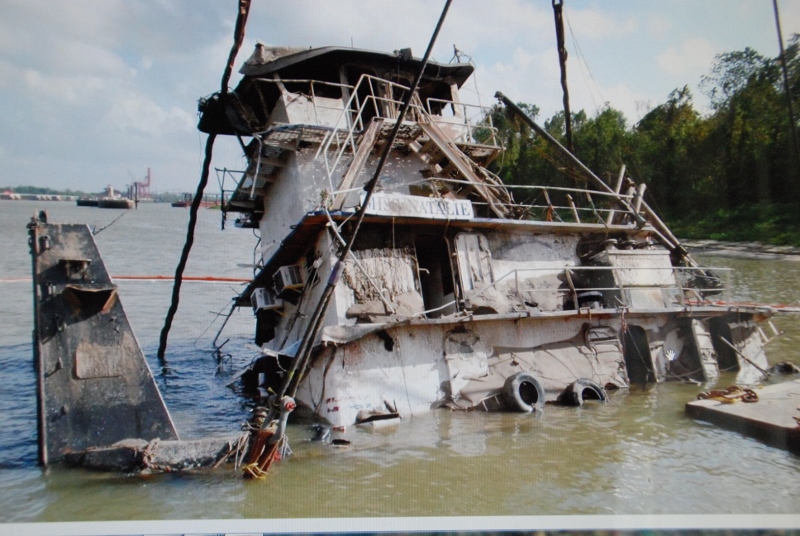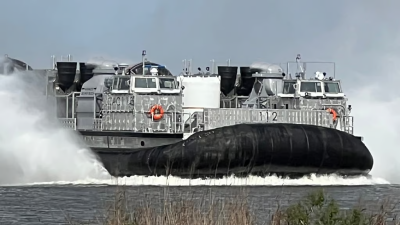Swift Mississippi River current during last year's high water and a captain’s decision to downstream toward an approaching barge tow contributed to a 2015 capsizing and the death of a crewmember, the National Transportation Safety Board said in a report on the accident.
The 59’x28’6”x7’7”, 1,600-hp fleeting towboat Miss Natalie, operated by Western Rivers Boat Management, was pinned against the bow of a coal barge it was to move, rolled over and sank near Convent, La., on May 30, 2015. Three crewmembers scrambled onto the tow, while the captain in a life vest was washed out of the pilothouse. A fourth crewman drowned in the vessel.
In its findings, the NTSB reiterated cautions issued in a joint Coast Guard-American Waterways Operators 1999 study of downstreaming maneuvers and their potential hazards.
In most circumstances, downstreaming is practical and safe, that analysis found.
“However, when casualties do occur, the risk to vessel crew is very high and the options for escape are limited,” the authors warned. Smaller towboats of lesser horsepower operating in high-water conditions are more at risk, they noted.
In the Miss Natalie case, NTSB investigators cited an estimated river current near mile marker 162 that may have been as high as 5.5 knots, and noted the barge tow was still moving forward at over 2 knots. As the Miss Natalie approached the barge to make contact, the towboat’s stern swung suddenly to port and the captain was unable to regain control, the report said.
The probable case of the sinking was “the captain’s decision to downstream on a line-haul tow given the prevailing conditions,” combined with the continued forward motion of the tow, the report concluded.
The tow, pushed by Chem Carriers LLC's 2,520-hp, 95’x30’x8’5” George W. Banta, included eight 200’ barges carrying corn and soybeans, plus the 195’ coal barge in the port bow position. The plan was for the Miss Natalie to move the coal barge over to the starboard side of the tow.
Over the radio, the Miss Natalie captain said he planned to downstream to the tow. The tow captain questioned that, asking if there was an alternative. Miss Natalie’s master assured the other captain “he had accomplished this task numerous times,” the investigators noted. In his interviews with the Coast Guard, the captain said he had accomplished hundreds of downstreaming approaches while working in fleeting operations since 2007.
As the fleeting towboat closed, deckhands noticed the tow was still moving forward and warned the captain, who began backing down. When the vessels were just a few feet apart, the towboat’s stern suddenly swung. Gunning all four engines in forward and then reverse, the captain was unable to separate from the barge, and the Miss Natalie began to list at 45°.
Pinned under the barge rakes, the towboat began taking water through two open doors on the main deck. Inside, two deckhands had been awakened by the collision. One who made his way out told investigators he saw the other man go back into his stateroom. His remains were found when the towboat was salvaged nearly five months later.
The Coast Guard-AWO analysis looked at downstreaming incidents in the 1990s including a number of fatalities. Its warnings figured prominently in the NTSB’s Miss Natalie report.
“If the towboat meets the barge at an angle, and if there is a strong enough current, the boat may become pinned sideways against the barge. In these cases, water may rise up onto the deck and enter the vessel itself through doors or windows,” the 1999 downstreaming report said. “The vessel may capsize and sink, or, if it is pinned under the rakes of the barges, be pulled down under the fleet itself.
“Survivors or witnesses have described incidents as happening with surprising speed, with the vessel sinking in less than one minute. Crewmembers unable to climb onto the fleet, or rescue vessels, are at extreme risk.”





